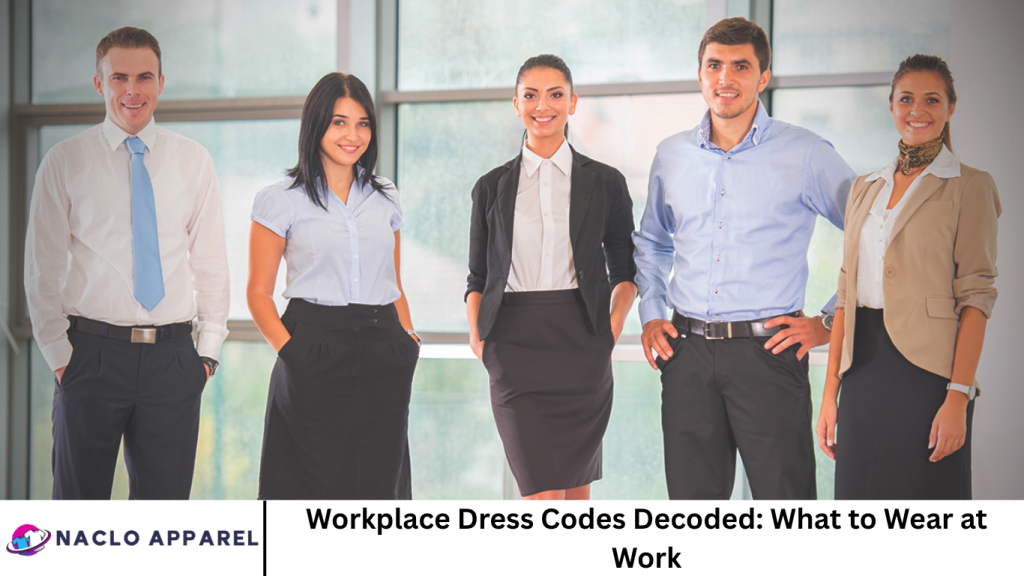Whether you’re a fresh graduate stepping into your first office job or a seasoned professional navigating a new workplace culture, one question remains universal: What should I wear to work? In today’s evolving professional landscape, dress codes vary widely between industries, companies, and even departments.
From formal suits to flexible athleisure, the rules are no longer black and white. Understanding and adhering to workplace dress codes is more than just following protocol—it’s about making a strong first impression, expressing professionalism, and respecting your work culture.
In a world where first impressions matter and professional image counts, knowing what to wear at work can feel like navigating a maze. From strict suits in law offices to jeans-and-sneakers startups, workplace dress codes can vary wildly—and getting it wrong can be awkward or even career-limiting.
More Read: Top Fashion Trends for 2025, According to Leading Stylists
Why Workplace Dress Codes Matter
The Power of Appearance
Your clothing speaks before you do. In many industries, what you wear reflects your credibility, confidence, and ability to fit in with company culture.
- Professionalism: Dressing appropriately shows you understand workplace norms.
- Respect: Following a dress code demonstrates respect for your employer, colleagues, and clients.
- Confidence Boost: When you feel good about your outfit, it enhances self-esteem and productivity.
The Main Types of Workplace Dress Codes
Business Formal
Best for: Law firms, finance, government, corporate boardrooms
Key Elements:
- Tailored suits (blazers, slacks or skirt, button-up shirts)
- Closed-toe dress shoes
- Minimalist accessories
- Neutrals or dark colors like navy, black, gray
Tips:
Opt for timeless, quality pieces. Iron your shirts and polish your shoes—presentation matters in this setting.
Business Professional
Best for: Corporate offices, client-facing roles, administrative positions
Key Elements:
- Slacks or skirts with blouses or collared shirts
- Blazers optional
- Conservative colors and patterns
- Dress shoes or modest heels
Tips:
Think of this as “business formal lite.” It’s polished but allows slightly more color or softer fabrics.
Business Casual
Best for: Tech companies, educational institutions, creative agencies
Key Elements:
- Chinos or dress pants
- Sweaters, polo shirts, or non-wrinkled button-ups
- Blouses and knee-length skirts or dresses
- Clean sneakers, loafers, or flats
Tips:
Avoid distressed jeans, loud graphics, or flip-flops. Layer smartly—cardigans or casual blazers elevate the look.
Casual
Best for: Startups, creative industries, remote jobs
Key Elements:
- Jeans (dark wash preferred), casual tops
- T-shirts (without slogans), sneakers
- Hoodies or sweaters
- Modest leggings (with long tops or tunics)
Tips:
Even in casual settings, maintain hygiene and wear clean, non-damaged clothes. Add subtle flair with accessories.
Uniform or Industry-Specific Dress
Best for: Healthcare, hospitality, construction, service roles
Key Elements:
- Company-provided uniforms or scrubs
- Safety gear (steel-toed boots, goggles, etc.)
- Name tags or branded apparel
Tips:
Keep uniforms clean and well-fitted. When off-duty, change to separate attire to maintain work-life boundaries.
Dressing for Remote or Hybrid Work
Remote work brings freedom, but you shouldn’t live in pajamas.
- Video Call Ready: Wear solid-colored tops and maintain grooming.
- Mental Shift: Dressing up, even slightly, can boost focus and signal the start of the workday.
- Balance Comfort and Style: Comfortable pants and knit tops are perfect.
Pro Tip: Keep a blazer nearby for surprise video meetings—it instantly elevates your look.
How to Interpret a Company’s Dress Code
Before day one at your job, observe and research:
- Read the Handbook: Most companies outline dress expectations clearly.
- Ask HR or Your Manager: It’s okay to request clarification.
- Observe Colleagues: Pay attention to what others wear, especially leadership.
- Be Cautious When in Doubt: Slightly overdressed is better than underdressed.
Dressing for Success by Industry
Tech and Startups
Often casual, but smart casual is safest. Avoid logos or offensive graphics.
Legal and Finance
Traditional and formal. Stick to suits or tailored separates.
Healthcare
Scrubs, lab coats, and closed-toe shoes are standard.
Creative Fields (Design, Media, Marketing)
Expressive but neat. You can be stylish with colors and textures, but avoid extremes.
Education
Business casual is the norm. Comfortable shoes are important for standing or walking.
What Not to Wear to Work
Avoid these common missteps unless your workplace explicitly permits them:
- Wrinkled, torn, or dirty clothing
- Flip-flops or worn-out sneakers
- Revealing or overly tight outfits
- Graphic tees with political or offensive messages
- Excessive perfume or cologne
- Unkempt hair or lack of grooming
Gender-Inclusive Style Tips
Dress codes today are increasingly inclusive. Here’s how to respect the code and express your identity:
- Gender-Neutral Outfits: Blazers, trousers, button-up shirts, and loafers suit anyone.
- Tailoring Is Key: Fit matters more than gendered styling.
- Confidence Matters: Choose pieces that align with your personal style while staying workplace-appropriate.
Seasonal Dressing Tips
Summer
- Breathable fabrics (cotton, linen)
- Avoid visible sweat marks—opt for layering or dark colors
- Wear lighter tones and smart sandals if permitted
Winter
- Layer with blazers, sweaters, scarves
- Closed-toe boots and coats should still look polished
- Avoid bulky, oversized pieces that look too casual
Building a Workwear Wardrobe
Essentials Checklist
- 2–3 dress shirts or blouses
- 1–2 pairs of tailored trousers
- 1 blazer or cardigan
- 1 pair of closed-toe shoes
- 1 professional bag or backpack
Neutral base items you can mix and match
Invest in quality, versatile basics. Over time, add pops of color and accessories to reflect your personality.
Expressing Personality Within Dress Codes
Even within strict guidelines, you can show personality:
- Accessories: Watches, scarves, subtle jewelry
- Patterns and Colors: Try pastels, muted florals, or pinstripes
- Shoes and Bags: Add texture or a pop of color
- Hair and Makeup: Clean, creative, but not distracting
Frequently Asked Question
How do I know what dress code my office follows?
Start by reading the employee handbook or HR guidelines. Observe what others wear, especially your manager, and don’t hesitate to ask for clarification.
Can I wear jeans to work?
In business casual or casual environments, dark, clean jeans are usually acceptable. Always check if your company allows denim.
What should I wear to a job interview if I’m unsure about the dress code?
Lean toward business professional. A blazer, button-up, or modest blouse with slacks is a safe bet.
How do I stay stylish in a strict dress code?
Incorporate tailored pieces, interesting textures, and tasteful accessories. Fit and quality elevate any outfit.
Are dress codes discriminatory?
Dress codes must be applied fairly and consistently. If a code targets specific groups or identities, it could be discriminatory and should be reported to HR.
Can I dress casually when working from home?
Yes, but avoid looking unkempt—especially for video calls. A neat, casual top and grooming go a long way.
How often should I update my work wardrobe?
Refresh basics every 6–12 months and update based on seasonal needs or role changes. Quality pieces last longer and reduce the need for frequent shopping.
Conclusion
Navigating workplace dress codes doesn’t have to be confusing or stressful. When you understand the expectations, align with company culture, and dress with intention, you’ll strike the perfect balance between professionalism and self-expression. Whether you’re stepping into a corporate boardroom or logging in from your home office, your attire plays a powerful role in how you’re perceived and how you feel. Dress not just for the job you have—but for the career you want.


